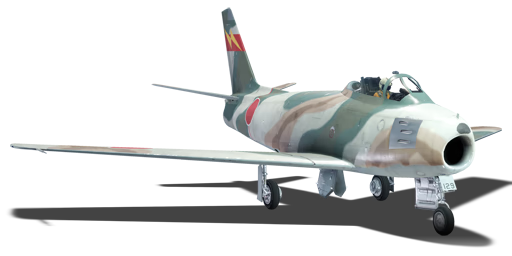



Considered one of the premier fighter aircraft of the day, several nations put bids in to receive surplus F-86 fighters to add to their arsenal. Japan successfully acquired this aircraft, however, due to the popularity of the aircraft, supplies evaporated. Though North American Aviation restarted production of the aircraft, Japan successfully lobbied to acquire the licensing rights to have Mitsubishi begin production of the aircraft, allowing Japan to increase its air force's offensive and defensive capabilities sooner than expected.
It was introduced as a premium pack in Update 1.87 "Locked On" but was removed from the store after the 2022 Summer sale. It was later reintroduced as a premium vehicle purchasable in-game with Golden Eagles in Update "Drone Age". Though not one of the fastest aircraft during this time period, it can be one of the most manoeuvrable when considering throttle control, air-brakes and the wing slats. The manoeuvrability of this aircraft is definitely a plus when flying against other fighters which could be considered more of a manned-missile with lots of speed, but a horrible turning radius.
flaps
flaps
flaps
brake
| Belt | Belt filling | Armor penetration (mm) at a distance: | |||||
|---|---|---|---|---|---|---|---|
| 10 m | 100 m | 500 m | 1000 m | 1500 m | 2000 m | ||
| API-T/AP/AP/I | 30 | 27 | 20 | 13 | 9 | 6 | |
| AP-I/AP-I/API-T/I/I | 28 | 26 | 18 | 11 | 7 | 4 | |
| API-T/I/AP/AP/AP-I/AP-I | 30 | 27 | 20 | 13 | 9 | 6 | |
| API-T | 28 | 26 | 18 | 11 | 7 | 4 | |
| AP-I/I/AP-I/I | 28 | 26 | 18 | 11 | 7 | 4 | |
8 × HVAR rockets







 2 x (130 / 380 / 600) %
2 x (130 / 380 / 600) % 
 2 x 208 %
2 x 208 % 

Flight performance | |
|---|---|
Survivability |
|---|
Weaponry | |
|---|---|